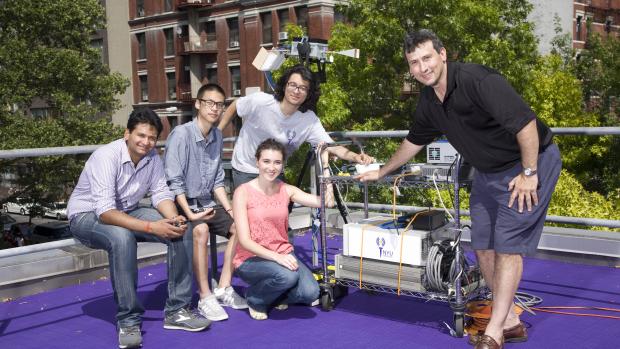NYU and NYU-Poly Launch World’s First Academic Research Center to Combine Medicine with Wireless Communications and Computing
25 Faculty and 100 Student Researchers Work with National Instruments and Other Industry, Federal Partners to Advance Wireless Technologies and Applications

New York University and Polytechnic Institute of NYU (NYU-Poly) announced that National Instruments (NI) is joining them as the founding industrial sponsor in launching the world’s first academic research center combining the exploration of advanced wireless technologies, computing and medical applications.
Called NYU WIRELESS, the center researches advanced communications and antenna technologies, compressed sensing for spectrum efficiency in massively broadband wireless communications and medical imaging, the creation of smaller and smarter cellular networks and wireless devices that cooperate rather than compete for spectrum. The center also focuses on creating fundamental knowledge of wireless methods and new circuits and systems for a promising new frontier in the wireless spectrum: millimeter-wave and sub-terahertz communications.
NYU WIRELESS has enlisted 25 engineering, computer science and medical professors and more than 100 graduate students and post-doctoral researchers. They will work with researchers from NI, major federal funding sources such as the National Science Foundation (NSF) and the National Institutes of Health (NIH) and subsequent industry partners. Hardware and software from NI will serve as a test bed solution for some of the new research initiatives.
New research space totaling 14,500 square feet is scheduled to open on the downtown Brooklyn campus of NYU-Poly this winter. The new center brings together faculty who have current research projects that total approximately $10 million annually.
“National Instruments is excited to be part of this important research initiative,” said Director of National Instruments Software Defined Radio James Kimery. “The graphical system design approach enabled by LabVIEW software provides heterogeneous processing capabilities in a unified, integrated design flow that will enable NYU WIRELESS research to iterate faster and prove out the ideas in a shorter time. NI’s software-defined radio platforms will serve as the hardware prototyping test bed encompassing real-time operating systems, multi-core processors, FPGAs and flexible RF frontends.”
NYU WIRELESS is founded and directed by Professor Theodore (Ted) Rappaport, who recently joined the faculty of NYU-Poly’s Computer and Electrical Engineering Department, NYU’s Courant Institute of Mathematical Sciences and the Department of Radiology at NYU Langone Medical Center. Faculty and students from all three schools comprise NYU WIRELESS. Rappaport previously founded major academic wireless centers, at Virginia Tech and The University of Texas, as well as two companies instrumental in building today's cellular industry.
“By working with some of the world's best doctors and surgeons, we can solve real problems in the medical field while bringing our industry sponsors in direct contact with engineering problems and market opportunities in health care," said Rappaport. "And by moving up the spectrum, a new frontier opens to wireless innovation. The millimeter-wave spectrum is uncrowded – with enough capacity to accommodate breakthroughs in cellular and personal wireless communication networks. All our researchers eagerly embrace this unprecedented interdisciplinary collaboration as an opportunity to shape the future of wireless communications and make meaningful contributions to lives and health in our world.”
“No other wireless research center in the country can claim this level of interdisciplinary cooperation, with the ability to validate research on actual patients, said Professor Daniel K. Sodickson, M.D., Ph.D., vice-chair for research, Department of Radiology and director of the Bernard and Irene Schwartz Center for Biomedical Imaging at NYU Langone Medical Center. “NYU WIRELESS will conduct cutting-edge medical research in radiology, and it is also poised to make fundamental contributions in areas such as neuroengineering, cardiovascular engineering and electrophysiology.”
NYU WIRELESS researchers have also started to measure the reaction of millimeter-length radio waves as they bounce against and travel through buildings in Brooklyn and Manhattan. Operating at radio frequencies of 20 to 60 GHz – ten times higher than today's cell phones and Wi-Fi networks – they offer higher data rates at lower cost, but the propagation of the signals in urban environments poses difficult technological challenges.




